Small landholdings modernisation: consultation analysis
This report outlines the results of a consultation held from October 2022 to January 2023. The consultation aimed to gather views on proposals to modernise and update small landholdings legislation.
5. Additional considerations and impacts
This section of the report outlines the consultation findings in relation to the fifth set of questions on additional considerations and impacts.
Key findings
Respondents were able to give their views on further potential changes to small landholding legislation to support small landholders and their landlords. They raised a number of issues, including: changes to agricultural tenancy types; support for new entrants; and the role that small landholdings can play in meeting climate and biodiversity goals due to their scale.
Over a third (39%) of respondents said they were aware of potential costs and burdens that may arise as a result of the proposals. The main potential costs identified by respondents were: costs in purchasing the land; the cost of funding the purchase; legal costs; the wider cost of new legislation and regulations, for example to the public, and; the loss of small landholdings and the opportunities they offer to new entrants and start-ups.
In terms of environmental impacts, whilst some respondents felt that the proposals would lead to positive environmental impacts, for example through diversification and greater participation in environmental schemes, others felt there was a risk of negative impacts in terms of the loss of small landholdings and the effective management of agricultural land.
Over a third (37%) of respondents said they were aware of current or future impacts on young people due to the proposals. Around a fifth (17%) were not aware of any impacts. Whilst some felt the proposals would have a positive impact on young people in terms of opportunities for new entrants, others felt the proposals would have a negative impact in this area.
Almost a third (32%) of respondents thought improvements could be made from a young person’s perspective. Only a small number (5%) said ‘No’. Their answers focused on several key issues: the need to simplify the small landholding system; support for new entrants and the need to broaden access to land and tenancy opportunities within the agricultural sector.
Around half of respondents (46%) were not aware of any impacts of the proposals on data protection or privacy, and a quarter (24%) were unsure.
Around half of respondents (46%) said they were not aware of any examples of how the proposals in this consultation paper may impact those with protected characteristics. Respondents raised several points: succession, and the positive impacts of widening opportunities in rural areas; the importance of protecting the rights of all small landholders; the potentially negative impacts of a loss of small landholding tenancies on diversity in the agricultural sector and in rural areas.
Around a third (32%) of respondents said they were not aware of any examples of how the proposals might have particular impacts on groups or areas experiencing socioeconomic disadvantage. A fifth (20%) said they were aware of potential impacts and a fifth were unsure.
Respondents noted potential positive impacts including: benefits to rural communities and services; and the benefits to small landholders experiencing socioeconomic disadvantage. One potentially negative impact was the decline of small agricultural tenancies, which could restrict access to rural land for small-scale and local food production.
Almost a third (29%) of respondents were not aware of any examples of any potential differential impact of the proposals on island communities. Around a quarter (24%) were aware of potential impacts. Respondents identified a number of potential benefits of the proposals to island communities in terms of: increasing access to employment and housing; bringing in new residents; and small landholders on islands more control over their future.
This section of the report outlines the consultation findings in relation to the fifth set of questions on additional considerations and impacts, which focused on:
- Further potential changes to small landholding legislation to support small landholders and their landlords;
- Potential costs and burdens that may arise due to the consultation proposals;
- Potential environmental impacts of the proposals;
- Potential current or future impacts on young people;
- Potential improvements from a young person’s perspective;
- Potential impacts on data protection or privacy;
- Potential impacts on those with protected characteristics;
- Potential impacts on groups or areas experiencing socioeconomic disadvantage; and
- Potential impacts of the proposals on island communities
5.O Wider feedback on potential changes to the current small landholding legislation to modernise small landholdings
Key findings
In this section, respondents were able to give their views on further potential changes to small landholding legislation to support small landholders and their landlords. They raised a number of issues, including: changes to agricultural tenancy types; support for new entrants; and the role that small landholdings can play in meeting climate and biodiversity goals due to their scale.
Respondents were asked if there was anything else they thought should be changed in the current small landholding legislation to modernise small landholdings, so they can play their part helping to tackle the climate and biodiversity crises and for Scotland to reach Net Zero by 2045. There were 28 responses to this question. Respondents raised a number of wider issues in their answers, including:
- The need for consistency across agricultural legislation i.e. wider changes in the sector to be applied to small landholdings.
- Changes to small landholding legislation should be in line with expectations of other farmers and landowners.
- Support for new entrants, including in small landholdings.
- Need to consider other types of financial support, e.g. guaranteed income raised from annual ground rent to support small landholders.
- Suggested changes to agricultural tenancy types.
In terms of enabling small landholders to have a role in tackling the climate and biodiversity crises, the key points raised were:
- Need for simplified language and clear guidelines or codes of practice for small landholders, for example in terms of environmental activities.
- Legislation should encourage the creation of more small landholdings, for example through financial incentives for landlords.
- Need to give small landholders long-term trust and security.
- Need for further support for climate activities on small landholdings, for example diversification, sustainable energy, electric vehicles.
- Recognition of the suitability of small landholdings for modernised farming practices, and the opportunities they offer due to their scale.
- Transparency of the Scottish Government’s climate goals, with targets in line with wider legislation.
- Clear delegation of costs, rights and responsibility, for example for small landholders in carrying out diversification activities to meet climate objectives, and limit on any penalties for doing so.
- The need to protect Scottish land for food and agriculture and maximise the potential of small-scale systems of land use for climate and nature.
- The view that there were a lack of proposals in the consultation to help address the climate crisis, and a lack of consideration given to the potential role of small landholders in this area.
Agricultural tenancy types
A number of respondents, largely organisations, reiterated earlier comments in terms of agricultural tenancy types, with the three responses being:
- Small landholdings should be brought within a modernised crofting framework;
- Small landholdings should be brought in line with tenant farming legislation;
- Small landholdings should be converted to secure agricultural tenancies.
A greater number of respondents to this question stated that small landholdings should be brought within the crofting framework – with small landholders having the same rights, protections, and responsibilities as crofters – as part of a wider reform of crofting legislation. Several referenced the need for fairness and equality in terms of the rights given to crofters but not small landholders during earlier reforms.
As one crofting organisation stated, this would help to protect agricultural land for future generations. The crofting framework has been designed for small-scale agricultural tenants, offers adequate rights and the protection, in addition to access to support, training and advice from bodies including the Crofting Commission and the Scottish Crofting Federation. They added that this was logical as a significant number of small landholdings are in designated crofting areas, and would be the most efficient and best use of public funds.
One organisation stated its concern in terms of the revision of small landholding legislation, and the fact that it may add to the complexity in this area if separate legislation continues to apply to small holdings. This organisation stated that a better option may be to consider incorporating a provision in the agricultural tenancies legislation for the conversion of small landholdings to secure agricultural tenancies so that they will all be governed by the same legislation.
Another organisation noted current confusion around legislation, and stated that some of the suggested changes could exacerbate this by creating further confusion between a small landholding, croft and agricultural tenancy. They raised a series of further points: the need to protect current relations between landlords and their tenants; the need for fairness to both parties; respect of landlords’ property rights; small landholdings are a legacy type of land tenure and should be dealt with in that context; the potential requirement to look more broadly at the rights of the landlord as well as tenants within this context of any changes.
Other suggestions included further additions to small landholdings legislation which exist in other forms of tenancies, including:
- Minimum duration of tenancies, for example of ten years;
- Compensation for improvements, for example at the end of a tenancy;
- Right to build a house on the land if there is no suitable property, subject to obtaining the approval from the local authority;
- An absolute right to buy for tenants i.e. they should be allowed to buy the land even if the landlord has not put it up for sale;
- Need for integration between Small Landholdings legislation, local planning and housing regulations, for example in island areas.
One further point raised by an individual was in terms of the registration of small land holdings since the 1931 Act, and problems in converting to crofting status due to issues with the register held by the Land Court and in meeting the legal criteria of being a Small Landholding tenant. They suggested that reasonable evidence should be acceptable proof of small landholding status and applicants should be accepted from all areas of Scotland.
Support for new entrants
Several respondents referenced the need to attract and support new entrants. As one organisation stated, the size of small landholdings can be attractive to new entrants and introduce them to farming at a manageable scale. It would be useful to consider if any provision would be appropriate in the legislation or as part of the role of the umbrella body, to support small landholdings as a particular opportunity for new entrants. In terms of support for new entrants, this included a specific point on improving grants for those who do not have sheds and slurry stores, and face high fertiliser costs as a result, and the beneficial environmental impact this would have.
Tackling the climate and biodiversity crises
In terms of climate activities, several respondents felt that further support should be offered to small landholders in carrying out these types of activities, including small wind and solar production, heat pumps, electric vehicles, heat pumps, rewilding, and further diversification. This included raising awareness and offering financial incentives or subsidies. As one organisation noted, the size of small landholdings means that their resources are often limited.
Several respondents commented on the need for transparency in terms of the Scottish Government’s wider goals in meeting Net Zero. For example, one suggested that there should be a schedule of changes to tackle the climate crisis, with appropriate support and protection in law, as this would help small landholders who face local challenges to new activities, and that this list should be responsive to innovation and new approaches.
As one respondent noted, introducing a minimum duration of tenancies would contribute to meeting climate and biodiversity goals as it would help to facilitate longer-term planning and activities such as tree planting, water and soil improvements. A minimum tenancy term would offer more scope to do this.
As one organisation stated, due to their scale, small landholdings may be more readily suited to a more modern farming framework focussing on biodiversity and climate change. There may be a particular opportunity to develop more flexible lease types for small landholdings that are less complex and more readily support the aims of this consultation. These would also be particularly attractive to new entrants and would help to support that part of the agricultural tenanted sector.
However, several organisations felt that there were a lack of relevant proposals that would help small landholders to play a role in tackling the climate and biodiversity crises, and that the Scottish Government should give more consideration to the role that small landholdings play in the tenanted sector and broader land use priorities.
For example, one organisation stated that the consultation proposals provided no safeguards to protect agricultural land and small-scale food production, and to protect extensive farming systems in High Nature Value areas, for example on Arran. As identified in the 2016 consultation, diminishing numbers of small landholdings are a key concern following introduction of a right-to-buy outside of crofting law and the duties to cultivate and maintain, and not to misuse or neglect.
This organisation was in favour of increasing numbers of small agricultural holdings within and outside crofting counties, and the creation of new crofts on public land.
Two organisations noted that the proposed changes may in fact have a negative impact on the climate and biodiversity, by leading to a reduction in the number of available small landholdings and less land being occupied for agricultural purposes. One stated that they would value the opportunity to take part in a round table discussion on this topic, to discuss options and alternatives.
5.P Potential costs and burdens of the consultation proposals
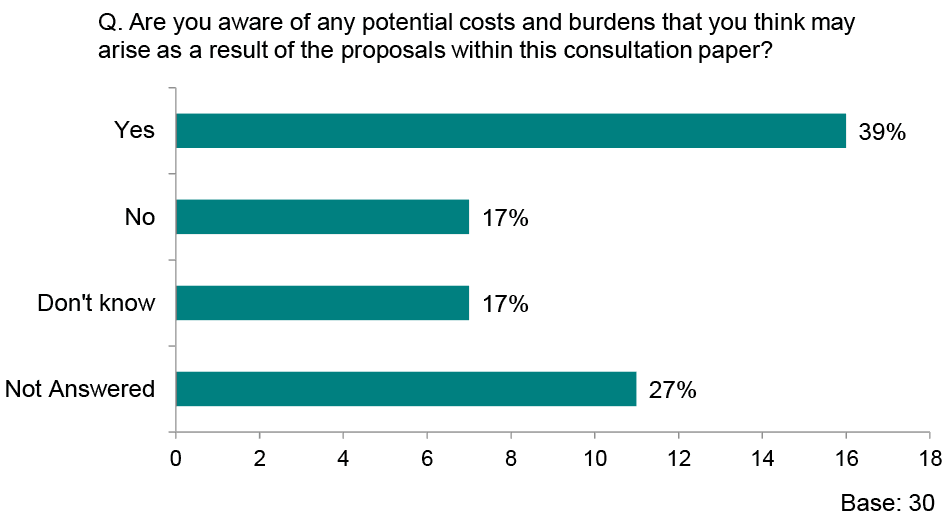
| Option | Total | Percent |
|---|---|---|
| Yes | 16 | 39.02% |
| No | 7 | 17.07% |
| Don't know | 7 | 17.07% |
| Not Answered | 11 | 26.83% |
Respondents were asked if they were aware of any potential costs and burdens that they think may arise as a result of the proposals within this consultation paper. Over a third (39%) said ‘Yes’, almost a fifth (17%) said ‘No’ and the same number said ‘Don’t know’ (17%). Over a quarter (27%) did not answer the question. Respondents were asked to give reasons for their answer and a total of 18 did so.
Key findings
Over a third (39%) of respondents said they were aware of potential costs and burdens that may arise as a result of the proposals within this consultation paper. Almost a fifth (17%) said they were not and the same number (17%) were unsure.
The main potential costs identified by respondents were: costs in purchasing the land, for example valuations, mortgage or conveyancing costs; the cost of funding the purchase; legal costs; the wider cost of new legislation and regulations, for example to the public, and; the loss of small landholdings and the opportunities they offer to new entrants and start-ups.
Respondents identified a number of costs, both for small landholders and their landlords and for the wider public. The main costs they identified were:
- costs in purchasing the land, for example valuations, mortgage or conveyancing costs;
- the cost of funding the purchase for example through current income, resources or borrowing;
- legal costs, for example legal fees, the cost of legal advice, sales and transactions, local authority planning systems;
- the wider cost of new legislation and regulations, for example to the public;
- the loss of small landholdings and the opportunities they offer to new entrants and start-ups, and potential human rights implications.
The first type of cost was of the most concern, with over a third of respondents (39%) to this question raising this. However, as several noted, these costs would be offset by the fact that small landholders have the opportunity to buy the land.
Lastly, one respondent stated that the process of selling and purchasing land may be burdensome to both land owners and small landholders, and have an impact on their relationship, which may lead to the loss of these holdings from the tenanted sector and the opportunities they offer to new entrants and start-ups.
5.Q Potential environmental impacts of the proposals
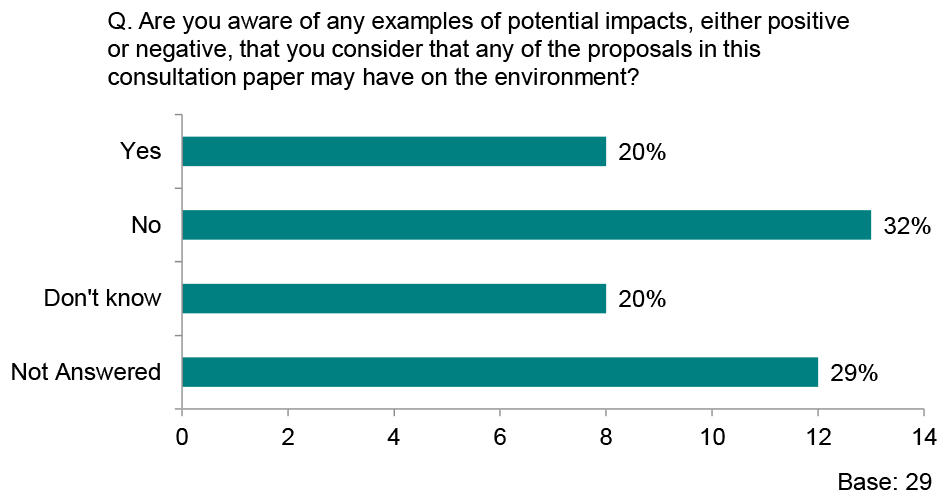
| Option | Total | Percent |
|---|---|---|
| Yes | 8 | 19.51% |
| No | 13 | 31.71% |
| Don't know | 8 | 19.51% |
| Not Answered | 12 | 29.27% |
Respondents were asked if they were aware of any examples of potential impacts, either positive or negative, that they consider that any of the proposals in this consultation paper may have on the environment. A fifth (20%) said ‘Yes’, almost a third (32%) said ‘No’ and a fifth said ‘Don’t know’ (20%). Almost a third (30%) did not answer the question.
Respondents were asked to give reasons for their answer and a total of 16 did so.
Key findings
Almost a third (32%) of respondents said they were not aware of any potential impacts that any of the proposals in this consultation paper may have on the environment. A fifth (20%) said they were, and a fifth were unsure.
Potential positive environmental impacts identified by respondents included: may speed up the decision-making process for environmental activities; tenants with greater security will invest more into their holdings and be more likely to participate in environmental schemes, and; the environmental benefits of keeping small landholdings occupied, from local food production to sustainable land management.
Other respondents identified potential negative impacts, largely in terms of the loss of small landholdings and the neglect or mis-use of agricultural land.
Lastly, several respondents stated that the consultation proposals were not relevant to this topic, and did not cover issues around land use and the environment.
A group of respondents felt that giving small landholders the right to buy would lead to positive environmental impacts, including through diversification.
Potential positive environmental impacts identified by respondents included:
- the changes may speed up the decision-making process for relevant projects, for example those addressing biodiversity and the climate;
- giving more rights to tenants will improve soil and water management, and tree growing;
- tenants with greater security will invest more into their holdings and be more likely to participate in environmental schemes.
- the environmental benefits of keeping small landholdings occupied, producing high quality local food and managing the land to reach its environmental potential, for example sustainable grazing of peatlands.
Respondents also stated that this would depend on the small landholder’s behaviour, the future use of the land and its new owner, and that any changes may be minimal if the existing occupier stays on the land after purchasing it.
Other respondents identified potential negative impacts, largely in terms of the loss of small landholdings and the neglect or mis-use of agricultural land. For example, one respondent felt that the proposals could have a negative environmental impact depending on the future use of this land and its buildings once it changes tenure.
One organisation stated that introducing a right-to-buy without statutory requirements to cultivate and maintain could lead to neglect and misuse of good land, and could be detrimental for the climate and nature particularly in terms of High Nature Value (HNV) farmland that relies on extensive agricultural practices.
Lastly, several respondents stated that the consultation proposals were not relevant to achieving net zero, or did not cover issues around land use and the environment.
5.R Potential current or future impacts on young people
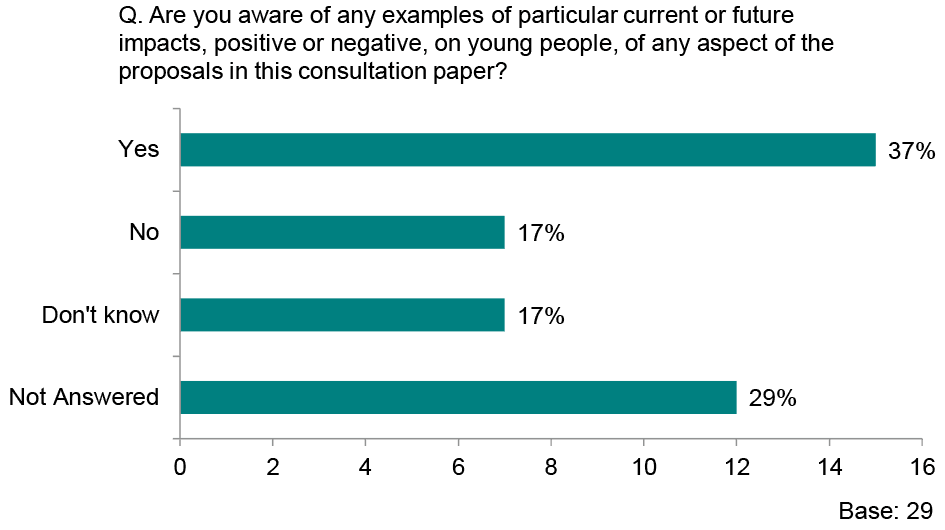
| Option | Total | Percent |
|---|---|---|
| Yes | 15 | 36.59% |
| No | 7 | 17.07% |
| Don't know | 7 | 17.07% |
| Not Answered | 12 | 29.27% |
Respondents were asked if they were aware of any examples of particular current or future impacts, positive or negative, on young people, of any aspect of the proposals in this consultation paper. Over a third (37%) said ‘Yes’, almost a fifth (17%) said ‘No’ and the same number said ‘Don’t know’ (17%). Almost a third (29%) did not answer the question.
Respondents were asked to give reasons for their answer and a total of 16 did so.
Key findings: Over a third (37%) of respondents said they were aware of current or future impacts on young people due to the proposals in this consultation paper. Around a fifth (17%) were not aware of any impacts.
Whilst some respondents felt the proposals would have a positive impact on young people in terms of opportunities for new entrants, others felt the proposals would have a negative impact in the longer-term, for example by leading to a reduction in opportunities for new entrants and the availability of land.
Positive impacts identified by respondents included:
- Securing the future of small landholdings for young people.
- Land reform, including greater diversification of land ownership, for local residents of all ages.
- The partial benefits to rural depopulation in keeping small landholdings occupied, for example in retaining those in younger age groups.
- Changes to succession could benefit younger people, giving access through inheritance to rural employment and careers.
- Giving great rights to small landholders will encourage the next generation to maintain an interest in the holdings.
- Affordable housing and the availability of small landholdings for future generations.
On the first point, several respondents felt that giving more opportunities to tenants to buy and subsequently sell their land will increase availability on the market to new and young farmers. As one noted, this will help to break up large estates, and make smaller, more affordable plots of land available to young people. They felt this would make a positive contribution to wider land reform in Scotland through greater diversification of land ownership. As one individual stated:
The proposals discussed will help secure the future of small landholdings which could prove to be an ideal stepping stone into agriculture and land management.
In contrast to above, several respondents felt that the proposals would lead to a reduction in opportunities for new entrants and start-up businesses, in terms of the availability of land. They felt that a reduction in the number of small landholdings available to let would mean less opportunities for young people to have a career in land management, and to join the industry. Respondents also noted longstanding rural issues, including employment and transport, and challenges faced by new entrants, including accessing funding to buy and lack of steady income.
One organisation noted that the separation of houses from the holding may make access to small landholdings more difficult for new entrants including young people, with significant shortages of housing in rural areas. Additionally, where land is purchased and made available on open markets (with competing claims for use) this will limit access to land for a new generation of small landholders.
As one organisation noted, the proposed changes relate to a particular group of small landholders and may benefit young people only in terms of potential successors who wish to acquire the land for residential, not agricultural use.
5.S Potential improvements from a young person’s perspective
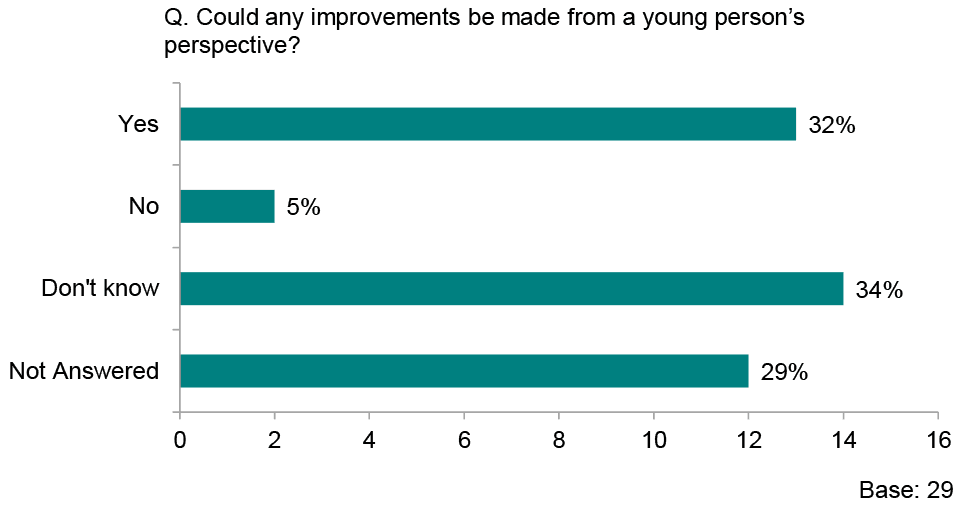
| Option | Total | Percent |
|---|---|---|
| Yes | 13 | 31.71% |
| No | 2 | 4.88% |
| Don't know | 14 | 34.15% |
| Not Answered | 12 | 29.27% |
Respondents were asked if they thought any improvements could be made from a young person’s perspective. Around a third (32%) said ‘Yes’, 5% said ‘No’ and over a third (34%) said ‘Don’t know’. Almost a third (29%) did not answer the question. Respondents were asked to give reasons for their answer and a total of 17 did so.
Key findings: Almost a third (32%) of respondents thought improvements could be made from a young person’s perspective. Only a small number (5%) said ‘No’.
Respondents focused on several key topics in their answers: the need to simplify the small landholding system; support for new entrants and the need to broaden access to land and tenancy opportunities within the agricultural sector.
Their responses can be summarised as follows:
- Support for new entrants, for example in terms of training, financial support, grants, access to land.
- Simplify the small holding system, by bringing it into line with crofting or other agricultural tenancies.
- Succession, including encouraging succession and assignation, and relaxing planning to enable tenants to build retirement accommodation.
- Thinking about how to expand agricultural letting, beyond protecting the rights of existing tenants.
In terms of support for new entrants, respondents' suggestions included: training and financial support, including grants for housing or livestock; start up subsidies, like an Apprenticeship Scheme; a national mortgage set at a fixed rate for the term of the mortgage; land reform and the need for wider access to land. As one noted, this is important in the current economic climate and the cost of living crisis.
In terms of simplifying the system, by bringing it into line with crofting or other agricultural tenancies, respondents stated that this would help to protect the land's capacity in terms of food production and environmental value, and increase the availability of small holdings for young people.
5.T Potential impacts on data protection or privacy
Key findings: Around half of respondents (46%) were not aware of any impacts of the proposals on data protection or privacy, and a quarter (24%) were unsure. No detailed responses were given to this question.
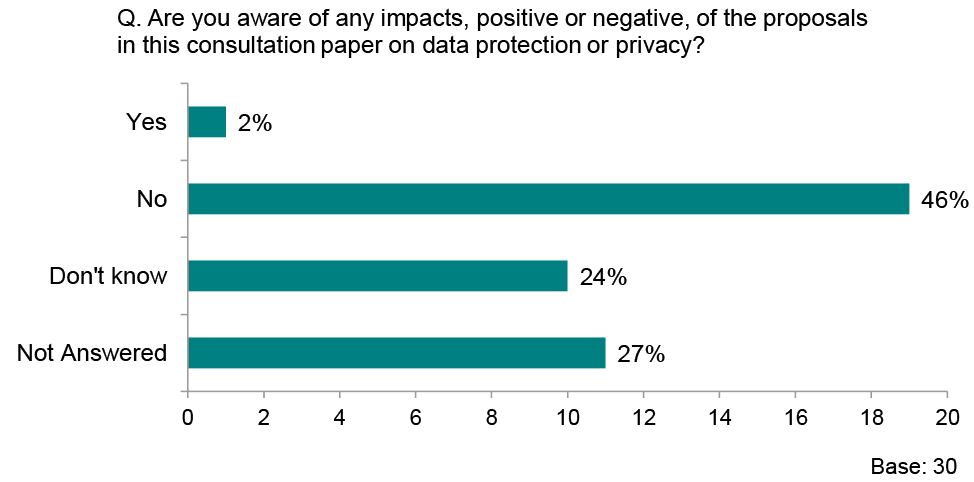
| Option | Total | Percent |
|---|---|---|
| Yes | 1 | 2.44% |
| No | 19 | 46.34% |
| Don't know | 10 | 24.39% |
| Not Answered | 11 | 26.83% |
Respondents were asked if they were aware of any impacts, positive or negative, of the proposals in this consultation paper on data protection or privacy. One respondent (2%) said ‘Yes’, around half (46%) said ‘No’ and a quarter (24%) said ‘Don’t know’. Almost a third (27%) did not answer the question.
No further responses were provided by respondents.
5.U Potential impacts on those with protected characteristics
Key findings: Around half of respondents (46%) said they were not aware of any examples of how the proposals in this consultation paper may impact those with protected characteristics. 7% said ‘Yes’ and a fifth (20%) were unsure.
Respondents raised several points: succession, and the positive impacts of widening opportunities in rural areas; the importance of protecting the rights of all small landholders; the potentially negative impacts of a loss of small landholding tenancies on diversity in the agricultural sector and in rural areas; the potential for discrimination toward small landholders with protected characteristics.
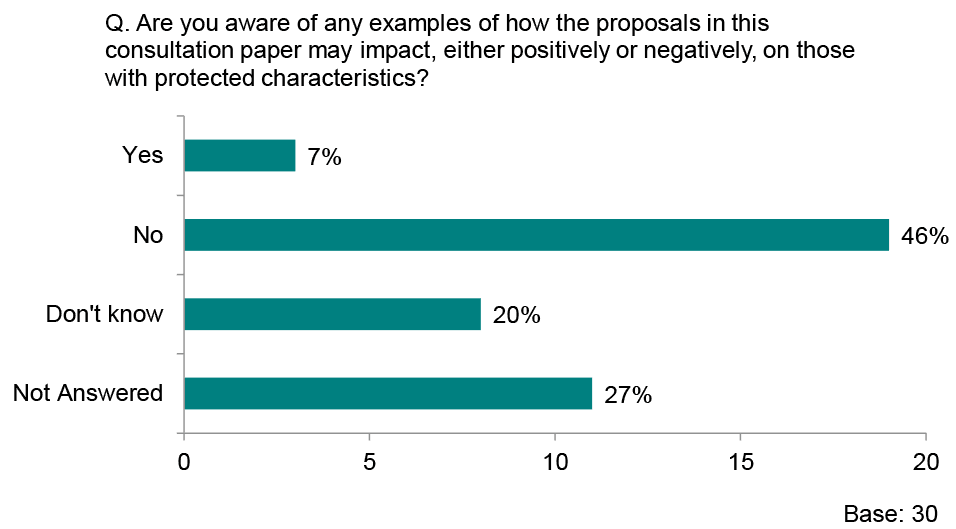
| Option | Total | Percent |
|---|---|---|
| Yes | 3 | 7.32% |
| No | 19 | 46.34% |
| Don't know | 8 | 19.51% |
| Not Answered | 11 | 26.83% |
Respondents were asked if they were aware of any examples of how the proposals in this consultation paper may impact, either positively or negatively, on those with protected characteristics.[6] A small number (7%) said ‘Yes’, around half (46%) said ‘No’ and a fifth (20%) said ‘Don’t know’. Around a quarter (27%) did not answer the question. Respondents were asked to give reasons for their answer and a total of 10 did so. They raised the following points:
- Succession, and the positive impacts of widening opportunities for other groups in rural areas;
- The importance of protecting the rights of small landholders to use the land, including those with protected characteristics;
- This issue is less relevant as the consultation is about how small holding land is held not by whom.
One organisation stated that the proposed changes could have a negative impact on those with protected characteristics by leading to a loss of small landholding tenancies out-with crofting areas, restricting opportunities for greater diversity in the small-scale agricultural sector and rural areas more widely.
One respondent raised concerns around the potential for discrimination in asking landlords to judge the ‘character’ of landholders, and how this may impact the relationship between landlords and tenants with protected characteristics.
5.V Potential impacts on groups or areas experiencing socioeconomic disadvantage
Key findings: Around a third (32%) of respondents said they were not aware of any examples of how the proposals might have particular impacts on groups or areas experiencing socioeconomic disadvantage. A fifth (20%) said they were aware of potential impacts and a fifth were unsure.
Respondents noted potential positive impacts including: benefits to rural communities and services; benefits to small landholders experiencing socioeconomic disadvantage, through introducing a right to buy. One potentially negative impact was the decline of small agricultural tenancies, which could restrict access to rural land for small-scale and local food production.
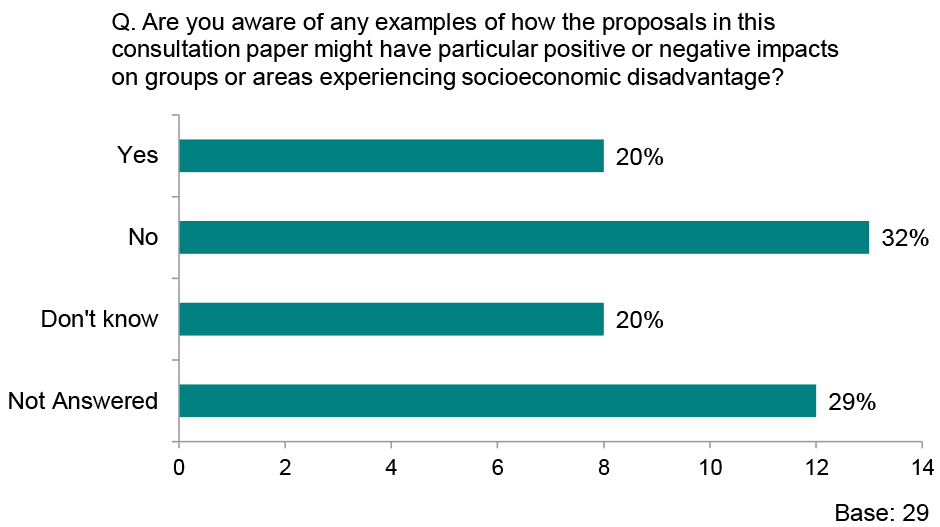
| Option | Total | Percent |
|---|---|---|
| Yes | 8 | 19.51% |
| No | 13 | 31.71% |
| Don't know | 8 | 19.51% |
| Not Answered | 12 | 29.27% |
Respondents were asked if they were aware of any examples of how the proposals in this consultation paper might have particular positive or negative impacts on groups or areas experiencing socioeconomic disadvantage. Around a third (32%) said ‘No’, a fifth (20%) said ‘Yes’, a fifth said ‘Don’t know’ and around a third (29%) did not answer the question.
Respondents were asked to give reasons for their answer and a total of 12 did so.
Potential positive impacts identified by respondents were:
- Benefits to small landholders currently experiencing socioeconomic disadvantage, for example through introducing a right to buy.
- Addressing economic inequality between tenants and landlords.
- Succession should be opened out to all to widen opportunity.
- Positive financial benefits, to rural economies and investment
- Wider benefits, for example to rural communities and services, through population retention.
Several respondents noted the potential benefits to rural communities and their economies through population retention, including supporting local services such as schools, housing and transport.
One organisation noted a potential negative impact, stating that the proposals in this consultation could lead to a decline of small agricultural tenancies outside of the crofting areas, and could further restrict access to land for small-scale and local food production in rural and remote areas.[7]
5.X Potential impacts of the proposals on island communities
Key findings: Almost a third (29%) of respondents were not aware of any examples of any potential differential impact of the proposals on island communities. Around a quarter (24%) said they were aware of potential impacts and 17% were unsure.
Respondents raised a number of wider points, including the need for fairness and consistency across mainland and island holdings, and to protect island small landholdings for future generations.
They also identified a number of potential benefits of the proposals to island communities in terms of: increasing access to employment and housing; bringing in new residents; and small landholders on islands more control over their future.
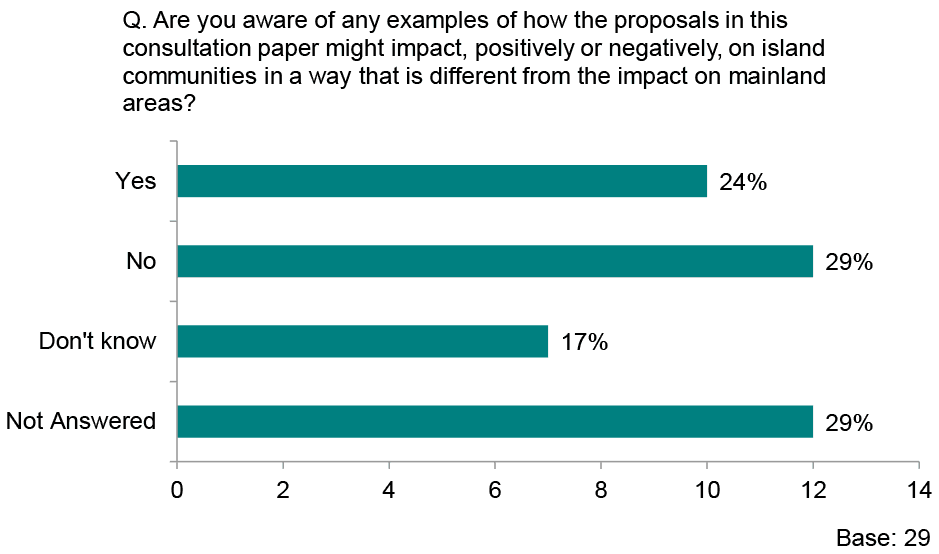
| Option | Total | Percent |
|---|---|---|
| Yes | 10 | 24.39% |
| No | 12 | 29.27% |
| Don't know | 7 | 17.07% |
| Not Answered | 12 | 29.27% |
Respondents were asked if they were aware of any examples of how the proposals in this consultation paper might impact, positively or negatively, on island communities in a way that is different from the impact on mainland areas. Around a quarter (24%) said ‘Yes’, almost a third (29%) said ‘No’, and a smaller number (17%) said ‘Don’t know’. Almost a third (29%) did not answer the question. Respondents were asked to give reasons for their answer and a total of 15 did so.
Respondents made a number of wider comments in answering this question:
- Small landholdings play an important role in island economies.
- Island communities are more sensitive to depopulation and the rural economy will benefit from new people and increased investment.
- There is a potential for different outcomes in terms of the extent to which small landholders on islands are able to capitalise on financial opportunities, for example in terms of developing and selling the land.
- There is an opportunity to give small landholders on islands access to further support and benefit communities if brought within the crofting framework.
- Depends on what is being produced and how it is being sold.
- Need for fairness and consistency across mainland and island holdings.
- The need to protect island small landholdings for future generations.
- Wider issues in rural and island areas including access to affordable housing.
Respondents identified potential benefits to island communities in terms of:
- Increasing access to employment and affordable housing.
- Bringing in new residents as small landholding tenants.
- Addressing inequalities between the mainland and islands by giving small landholders on islands more opportunities and control over their future.
However, one organisation raised concerns in terms of the proposals potentially leading to a decline of small landholding tenancies on Arran, a designated crofting area. As they stated, this would restrict access to land and opportunities for young people in areas of High Nature Value. They recommended that a study should be done to examine the potential impacts of converting small landholdings into crofts, for example on tenant’s rights, as opposed to the proposals put forward in this consultation.
Contact
There is a problem
Thanks for your feedback